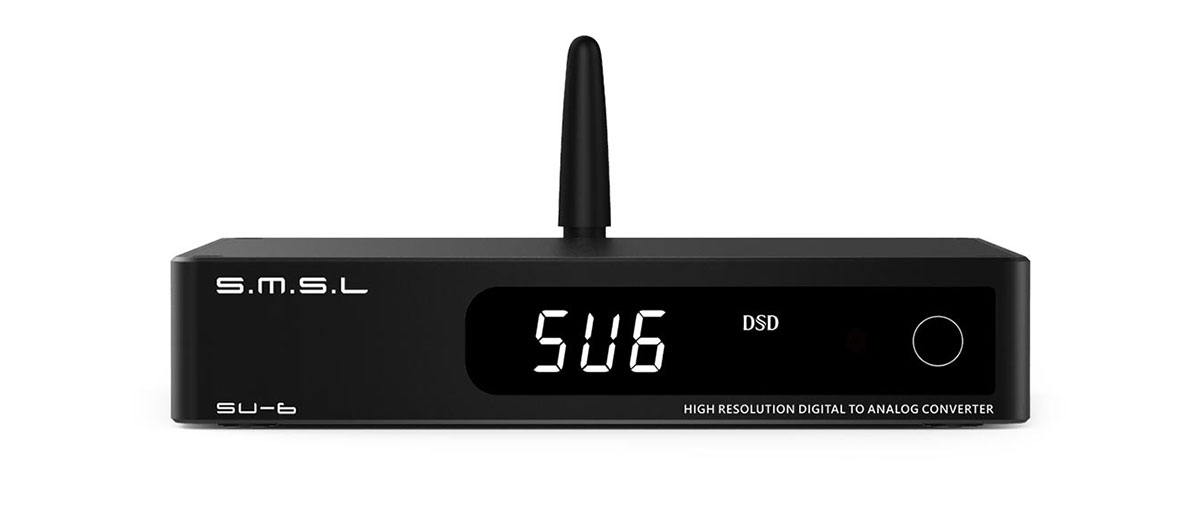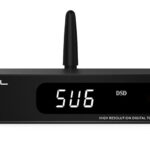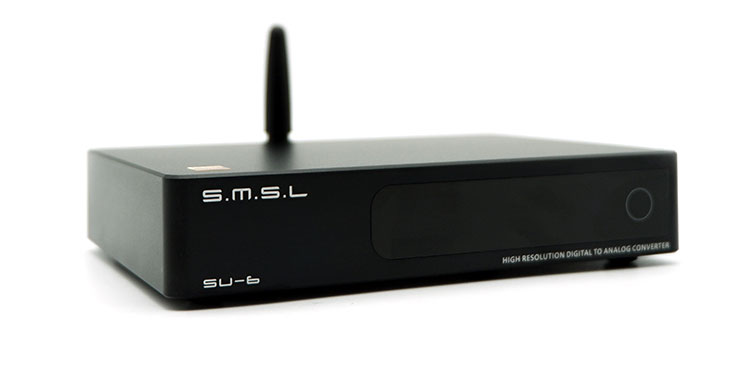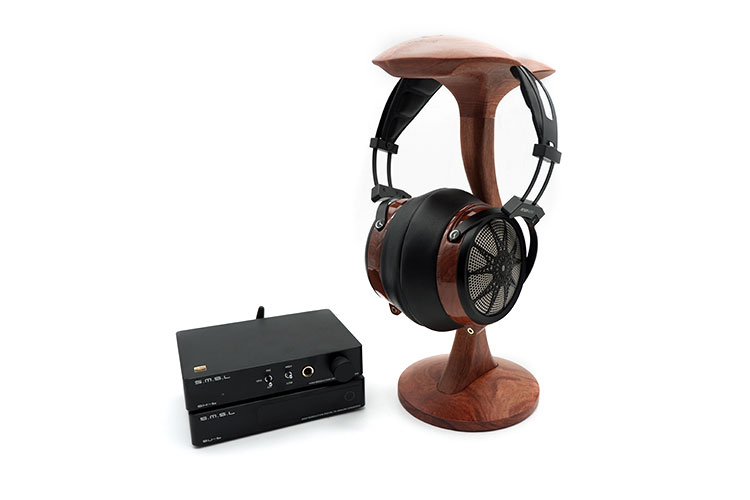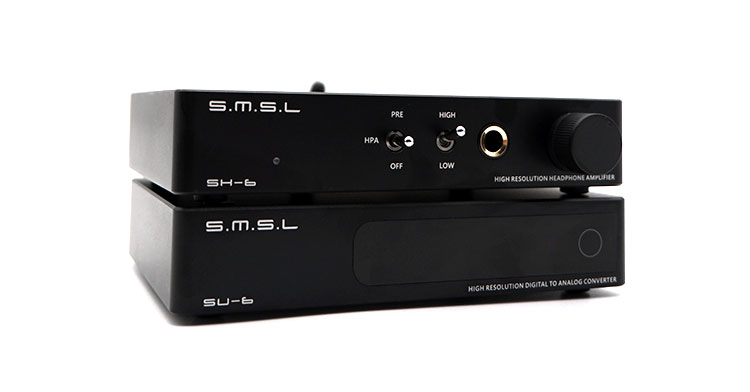Today’s review covers the SMSL SU-6 desktop ES9038Q2M DAC featuring Bluetooth 5.0 LDAC and up to DSD512 decoding. It is priced at $169.99.
Disclaimer: This was sent to us as a sample for our honest opinion. Headfonics is an independent website with no affiliate links or services. We thank Shenzhen Audio and SMSL for giving us this opportunity.
To read more about SMSL products we have covered previously on Headfonics click here.
Note, this 2-page article follows our latest scoring guidelines which you can read up on here.
While SMSL has been known for its high-value DAC offerings, its sub-$200 DACs have always been USB-powered desktop DACs such as the M100 MKII. This means that the power supply is typically dependent on the voltage regulation of the power being supplied by the upstream USB device.
Of course, finding a desktop DAC at below $200 is easy enough in today’s market, but they typically lack some of the functionality that their higher-priced counterparts have, like Bluetooth, multiple input options, or an adjustable preamp section.
With the release of the SMSL SU-6, SMSL has released a full-featured desktop DAC in a small package, and we’re here to find out more about it.
Tech Highlights
If I had a wish list of features for a desktop DAC at this price point, the SU-6 would tick most of the boxes on that list. It features a 2nd generation XMOS chip, which together with an ESS 9038 Q2M DAC allows the SU-6 to decode PCM 32bit/768kHz, and DSD512. Aside from the standard decoding capabilities, the SU-6 also features the latest Bluetooth chip from ESS.
The output section is then handled by an OPA1612 which gives the SU-6 a diminishingly low THD of 120dB. When it comes to dynamic range, the SU-6 has a really good amount of dynamic range at 125dB while having a preamp circuit in the output stage.
Design
With its form factor, the SU-6 can firmly be classified as a desktop DAC but it’s on the smaller side of that spectrum at 140 x 28 x 150mm. This means that it takes up a lot less desktop space than most other home audio solutions.
In front of the SU-6, there is a small screen that features a 3-character 7-segment display, which is used to convey information such as the input, and volume level. Then on the left, there is a touch-sensitive button that can be used to change the different modes of the DAC.
At the back, there is Bluetooth aerial input, then there are the different input, and output options as well. Finally, there is a removable power lead, which uses an IEC standard C7 socket instead of the more common IEC C13 power lead found in most other devices. This allows the designers of the SU-6 to have a bit more space inside the already small chassis of the SU-6.
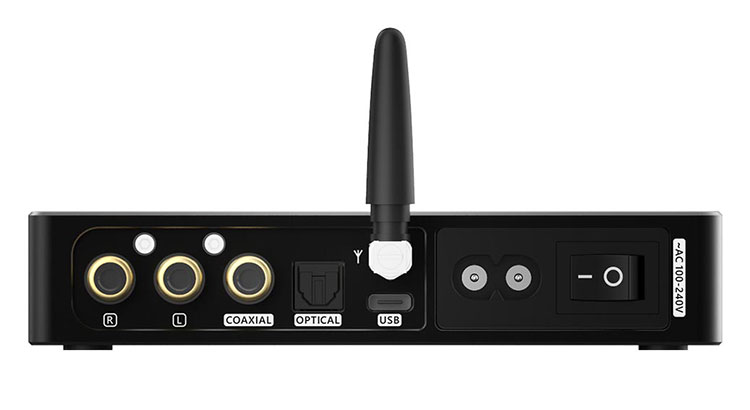
I/O
It’s interesting to see a DAC with such a versatile list of input options in such a small package. This includes options for Bluetooth input, USB, and coaxial.
The USB port on the SU-6 is a USB-C input instead of the more common USB-B port, presumably to save some space on the device. The output options, on the other hand, are much more limited with the SU-6, as it only has 1 pair of single-ended RCA outputs.
Controls
As mentioned earlier, there is a touch-sensitive button on the front fascia of the SU-6 to allow for switching between the different available input modes. However, the remote control provides for a more comprehensive set of controls which include volume control, filter options, brightness control, and DPLL controls aside from input selection.
Both control modes are intuitive enough, but being limited to a 7 segment display makes menu navigation, and by extension, adjusting the available menu options requires a bit of flipping through the manual to thoroughly understand.
Packaging & Accessories
The box that the SU-6 arrives in doesn’t stray too far away from what I have come to expect with packaging from SMSL products. It’s a simple white box with a picture of the product itself in front, then there’s some branding information such as the model of the DAC and of course the SMSL logo.
Inside the box, there are foam inserts that protect the DAC and its accessories. The DAC is neatly nestled inside the foam to make sure that it doesn’t move around too much during transport. Then the remote control, power cable, and Bluetooth antenna are all in the other compartment.
Sound Impressions
Summary
Most DACs strive to have a very neutral presentation to the point of being sterile. However, the SU-6 injects a good amount of personality, which gives it a more intense performance without being overwhelming. This presentation also optimizes the SU-6’s detail retrieval capabilities making it easy for textures and nuances easy to pick out.
Timbre
I would consider the SU-6 to be a DAC on the leaner side of the spectrum, which means that vocals tend to have a thinner character while presenting a good amount of vocal detail. This detail is also brought into the bass region, where the hollowness of the drum cavity is easily conveyed along with the textures of each drum hit.
Although there is some leanness in the presentation, it still brings along a good amount of intensity, perhaps at the cost of timbral accuracy. This results in drum hits sounding like being hit by a flat stick instead of a round one. This intensity bleeds into the midrange and treble, giving guitars a crunchy character, while cymbals have a good amount of edginess and sparkle.
With the leaner vocal presentation, it makes it a bit more difficult for the vocal presentation to be particularly euphonic. Fortunately, when there is a good amount of euphony in the track, to begin with, it still shines through naturally.
Despite having the appropriate amount of edginess, the treble range can be considered recessed compared to the rest of the frequency spectrum. The leaner character and the more recessed treble also make wind instruments less realistic than they ought to be since they sound smaller than expected.
Staging & Dynamics
While the SU-6 doesn’t have a particularly airy treble range, so it doesn’t artificially introduce a wider soundstage presentation. The lateral placement of instruments could be considered accurate in general, so elements that are panned from left to right accurately do so. However, images tend to stay within a single layer of the soundstage, without much layering within the soundscape.
Although the specs sheet lists a 125dB dynamic range, the SU-6 has a tendency toward sounding intense in most passages. This allows the SU-6 to readily convey large crescendos, but naturally recreating gentler passages like the tinkling of piano keys may pose more of a challenge.
Bluetooth
While Bluetooth connections are not the primary choice for critical listening, having a Bluetooth connection with the SU-6 is still a convenient feature. The one on the SU-6 features the most relevant codecs such as LDAC and aptX HD for an optimal experience.
Compared to wired connections such as USB, the Bluetooth connection on the SU-6 is comparably more intimate, while images tend to blur together more often. Also, there is a perceived lack of texture, while edges tend to be rounded off, making the SU-6 less intense than when it’s wired.
Synergy
Pairings
When the SU-6 was released, SMSL released an amp together with it called the SH-6, so it was only natural for me to pair the SH-6 with it. And this pairing ends up having a lot of ‘get up and go’, pushing the Sennheiser HD600 over the edge on dynamism, making each bass hit a bit too hard at times.
However, this character blended perfectly with the Sendy Audio Apollo planar magnetic headphone. Which gave the Apollo a better sense of PRaT, while having a sweet and natural vocal character. The upper treble lift on the Apollo also creates a more spacious soundstage presentation, allowing the space between images to be more tangible.
Swapping in the Topping L30 amplifier trades in the livelier character for a more full-bodied presentation. This pairing plays to the strengths of the HD600, giving it a more full-bodied presentation while maintaining the positional accuracy of the images.
Don’t expect this pairing to induce any artificial airiness though, so it doesn’t make the HD600 too wide while staying away from being too intimate.
Click on page 2 below for select comparisons

